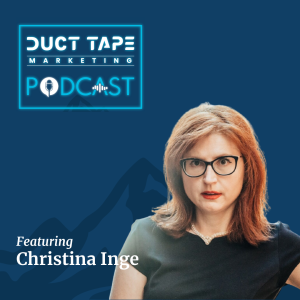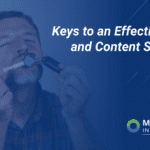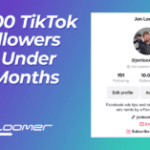Cracking the Code of Data-Driven Marketing
Cracking the Code of Data-Driven Marketing written by John Jantsch read more at Duct Tape Marketing
Marketing Podcast with Christina Inge
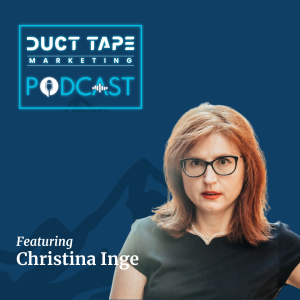 In this episode of the Duct Tape Marketing Podcast, I interview Christina Inge. She has two decades of experience leading digital strategy and managing complex marketing technology projects. She specializes in articulating effective, efficient digital strategies for organizations using the latest channels to drive results. She is the founder of Sleek Marketing, which offers hands-on education on digital marketing in the Boston area.
In this episode of the Duct Tape Marketing Podcast, I interview Christina Inge. She has two decades of experience leading digital strategy and managing complex marketing technology projects. She specializes in articulating effective, efficient digital strategies for organizations using the latest channels to drive results. She is the founder of Sleek Marketing, which offers hands-on education on digital marketing in the Boston area.
Her book Marketing Metrics: Leverage Analytics and Data to Optimize Marketing Strategies, is a practical guide to creating efficient future-focused marketing strategies powered by data-driven techniques that can develop stronger brands and products.
![]()
![]()
Key Takeaway:
Strategy is essential to manage a business today, and a data-driven strategy is one of the trending techniques to impulse your business growth. Christina mentions the importance of collecting, analyzing, and leveraging data and at the same time conducting experiments to have a competitive advantage in trends and in your market. The data you need to focus on should be anything related to ROI, unique KPIs, consumer perception, and the overall health of the branding and company. She emphasizes the idea that it’s not just about collecting data; it’s being smart about the data you collect.
Questions I ask Christina Inge:
- [01:50] When you’re talking to somebody about this idea of a data-driven strategy, how do you bridge that gap if they really aren’t working from a strategic framework anyway?
- [05:03] There is so much you could measure today, a lot of data to be analyzed. So how do we get to what’s the important stuff?
- [08:40] Are there some best practices in even assigning attribution or guessing or dividing attribution amongst channels?
- [10:51] How do you end up being smart and build empathy back into the data?
- [15:24] What role do consultants have in bringing data more to the forefront with their customers?
- [17:45] Talking about the changes in privacy, it’s not as easy to get some of the data that we used to get before. What do you see that businesses need to be doing?
- [21:35] What are you telling people about GA4 today?
More About Christina Inge:
- https://thoughtlight.net
- Get your copy: Marketing Metrics: Leverage Analytics and Data to Optimize Marketing Strategies
More About The Agency Certification Intensive Training:
- Learn more about the Agency Certification Intensive Training here
Take The Marketing Assessment:
- Marketingassessment.co
Like this show? Click on over and give us a review on iTunes, please!
John Jantsch (00:00): This episode of the Duct Tape Marketing Podcast is brought to you by Creative Elements hosted by Jay Klaus. It’s brought to you by the HubSpot Podcast Network. The audio destination for business professionals creative elements goes behind the scenes with today’s top creators. Through narrative interviews, Jay Klaus explores how creators like Tim Urban James Clear, Tory Dunlap and Cody Sanchez are building their audiences today. By learning how these creators make a living with their art and creativity, creative elements helps you gain the tools and confidence to do the same. In a recent episode, they talked with Kevin Perry about how he goes viral on every single platform. Listen to creative elements wherever you get your podcasts.
(00:52): Hello and welcome to another episode of the Duck Tape Marketing podcast. This is John Jantsch. My guest today is Christina Inge. Just two decades of experience leading digital strategy and management and managing complex marketing technology projects. She specializes in articulating effective, efficient digital strategies for organizations using the latest channels to drive results. She’s the founder of Sleek Marketing, which offers hands-on education on digital marketing in the Boston area, and she’s also the author of a book we’re gonna talk about today, Marketing Metrics: Leverage Analytics and Data to Optimize Marketing Strategies. So Christina, welcome to the show.
Christina Inge (01:34): Thank you John for having me here.
John Jantsch (01:36): So here’s my first question. When you use metrics and strategies in the same subtitle title, most businesses I end up running up against don’t have a strategy, let alone a data-driven strategy. So, so how when you’re talking to somebody about this idea of a data-driven strategy, how do you bridge that gap if they really aren’t working from a strategic framework anyway?
Christina Inge (01:59): I think most people, even if they’re not working from a strategic framework, either believe that they are, yeah,
John Jantsch (03:11): So, so you know, well, a lot of times when you work, what I hear you saying, I shouldn’t put words in your mouth, I’m gonna ask the question, is that a lot of people figure out what they’re gonna do and then say, let’s figure out how to measure it. And what you’re in some ways saying is, let’s look at what the data tells us to figure out what to do.
Christina Inge (03:29): Yes and no. So you should be always making data driven decisions. You should probably not be making decisions just based on gut feel or the mood of the moment. And I’m just, uh, swinging around here to be slightly less backlit, although I have that angelic look here going on. So you should be looking at the data to have it help you decide what to do. But you should also be conducting experiments. You should be doing ABM multivariate testing to test out hypotheses about what you should be doing. I’ll give you an example. So you can look at the data for what worked six months ago in a space like consumer, I don’t know, health and beauty, right? But what was on trend six months ago, what was on trend three months ago is not necessarily what’s on trend now. So if you go at that, go and look at that data and say, well, these particular influencers were really productive for us, or this kind of subject line in our emails or our marketing automation was very productive. It is not necessarily going to be the case right now. So I say, yeah, look at the data, but don’t just retroactively look at the data and then proactively predict forward. Well, predicting is a forward looking thing. Pride forward what you’re going to do, use that as a guide. But the past is only one of the many guides to what you should be doing. You should also be actively experimenting.
John Jantsch (04:55): One of the complaints of course, that I think people, uh, have today is there, you know, 20 years ago there was only so much you could measure today, lots of data, lots to be analyzed. So I mean, probably too much, right? In some cases. So how do we kind of get to what’s the important stuff?
Christina Inge (05:16): Anything that’s related to ROI is what you should focus on. I’m gonna say there’s three things you should be focusing on. One is anything related to roi, because at the end of the day, you’re either in the business of making money or if you’re a nonprofit, you’re in the business of serving a particular mission. And then your roi, it may not be monetary, but it’s gonna be there in elephants saved or disease cured or what have you. So you need to first and foremost say, am I doing things that help us meet our mission? Whether it’s shareholder value or saving elephants? Is this email campaign? Is this social media campaign, ad campaign, this combination of things, this customer, are any of these things helping us actually achieve that mission? And for that unique KPIs, key performance indicators that tell you, well, how will I know that we’re succeeding?
(06:07): So that’s the first thing, and I’ll get back to the issue of KPIs in a moment, but I wanted to also talk about, all right, what are the other two things that are help you narrow down to the metrics that matter? Not everything is gonna be a direct driver or even a quantifiable driver of roi. So for instance, if you have an outstanding, if you do a rebranding the way Campbell Soup recently did a rebranding, maybe more soup’s gonna fly off the shelves, maybe not. Maybe it’s gonna give them a little bit of a bump. But rebranding, people often don’t do it with the view towards all this is in and of itself, right? Going to cost people to stamped and buy my product. So you also want to measure consumer perception, your own positioning in the marketplace. And that takes it a step above ROI to the overall health of your branding your company.
(06:54): And then finally, if you wanna think about it as a Venn diagram where ROI is here, well may encompassing mo that mostly your brand health is here. Then the biggest circle of things you need to be measuring is your industry. You want to think about looking ahead to trends. Don’t forget, when you think about building a blue ocean strategy, one of the ways in which you can carve out a blue ocean for yourself. And if that’s not a mixed metaphor, I have no idea what, so we’re carving out an ocean and leveraging the ROI and running it up the flag pole. Oh my word. That’s way George jargon for a Monday afternoon is, which is when we’re recording this, but one of the ways in which you can create a blue ocean for yourself is by anticipating trends, right? Being ahead of the curve. Now, of course, the idea that there’s always a first mover advantage has been thoroughly debunked. In fact, that paper got retracted and cringe whenever anyone says first mover advantage. Cuz it’s not that simple. Sometimes there isn’t, sometimes there isn’t. But what you can’t afford to do in this world is be utterly oblivious to emerging trends. And instead simply being reactive or trying to be proactive, but only being proactive with a narrow time horizon. So time horizon A, look at your ROI of what you’re currently doing, time horizon B, look at the health of your brand and then the big time horizon start metricating overall industry trends.
John Jantsch (08:25): So on top of too much data, another thing that I hear quite often is this idea of attribution. How do I know exactly what did what, because the customer journey’s a little all over the place,
Christina Inge (08:51): There’s again, three things there that I tell people to focus on. One is, on a tactical level, you want to have a tagging system in place. Mm-hmm.
(09:45): Mm-hmm.
John Jantsch (10:25): So, and Oh, go ahead. Oh, I was just gonna say, if you wanna finish that point, cuz I’m gonna move on to completely different,
Christina Inge (10:33): Oh well really quickly. The biggest part of customer journey mapping that people leave out is empathy. You want to have an ability to put yourself in your consumer’s shoes. It’s not just the data, it’s being smart about the data.
John Jantsch (10:48): Hmm. Say more about that. Okay. How, how are you, how do you end up being smart and build empathy back into the data?
Christina Inge (10:55): Well, the nice thing is that there’s a couple of tools out there, and in case anybody’s wondering what the movement is over my shoulder here is I’m being photo bombed by my dog,
(11:52): Totally. And then I put up a picture of a teenage girl and it’s Joan of Arc, and I put up a picture of a person with a lot of kids and it’s Genghis Khan
(12:45): Because I tell you right now, Joan of Arc is not buying your car insurance from you
John Jantsch (13:29): What are they seeing? What are they hearing? What are they saying? Right? Right. Exactly. Yep.
Christina Inge (13:34): And that takes that persona who is still a two-dimensional figure, and you are right there with them and you’re understanding what they need. Like, gosh darn, I wish I had a catapult at this moment.
John Jantsch (13:46):
(14:34): And now word from our sponsor, are you ready to get out of spreadsheets? Look with HubSpot crm, get realtime data at your fingertips so your team stay in sync across the customer journey, build better content, generate more conversions, and get the context you need to create amazing experiences for your teams and your customers at scale. All from one powerful platform. It’s why more than 150,000 companies already use HubSpot’s CRM to run their businesses better. Plus, HubSpot’s user friendly interface sets you up for success from day one so you can spend less time managing software and more time on what matters your customers. There’s no better time to get organized, get started for free @hubspot.com today.
(15:23): So what role, because you do consulting, what role do consultants have in really bringing data more to the forefront with their customers? So a lot of marketing firms out there, yep. Say, oh, you want a website or you want leads, you know, we’ll get you that. But they’re not really, they’re certainly not leading or pushing a client to be more data-centric.
Christina Inge (15:44): Think the role that consultants plays a vital one, because we’re often perceived as more objective. And I would say arguably we often are, and that helps us look at the data without knowing so much of the backstory that we aren’t willing to consider certain things. So going back to my favorite analogy, if you’ve been trying to sell pet beds and you’re not selling them and you think, oh, we need to redesign the pet bed, and I come in with my crew and we say, no, the reason that your pet beds aren’t selling is because your target customer has an elephant, we are the ones willing to speak to the quote, literally or figuratively, usually figuratively elephant in the room, right? And say, okay, the fundamental assumptions here are wrong. We can do that from place of emotional safety. That’s part of it. I think the other vital role customers play is again, that fresh perception, which comes down to the fact that we can conduct data audits or other inventories or even just questions asked about what kind of data are you collecting and identify gaps that people have learned to live with.
(16:51): I mean, I’m a lifelong Bostonian and I can tell you that when people come to town, they’re often absolutely shocked about how much we live with potholes. We’ve gotten used to it, we take it for granted. Oh yeah, the streets are filled with potholes, whatever. And it takes an outsider to say, wait a minute, the streets are filled with potholes. Now mind you, I can’t go out and fill those potholes. So it’s, the analogy falls apart, but the point here being, it often takes that external perception to tell you what’s actually happening beyond just sort of puncturing those common assumptions, which people often desperately want you to question, but you are also actually asking, well where’s the state of com coming from? That’s very
John Jantsch (17:36): Valuable. All right, so I’m gonna, we don’t have all the time that it will take for you to answer this next question
Christina Inge (17:43): Like to
John Jantsch (17:44):
Christina Inge (18:10): You know, don’t, I can actually answer this pretty quickly because I would say it’s two things. One is double down on your own first party data, right? Make sure that you’re doing data audits, making sure your data is ethically collected. In other words, it’s fully opted in and make sure it’s clean. I guarantee you most people’s data is not as clean as they’d like. It’s kind of like your refrigerator, your fridge is never as clean as you’d like. Neither is your data. The other thing you want to do is start going old school, in my opinion, which is figuring out what are the proxies for the data that you can no longer collect. I mean, even Google is using predictive modeling to fill in the gaps that are resulting from people opting into integrated privacy protection, whether it’s legally mandated or not. What I mean by that is I’ve been in marketing long enough that I remember when you had to target people by the magazines they read and those kinds of targeting where you’re targeting people by a self-evident, self-selected and self-identified interest are not bad. And we have to get back to thinking like that. To go back to my analogy, if you are trying to figure out what you can sell to Hannibal Alexander, the Great Joan of Arc and Genus Khan, if you were forget their age, forget their other demographics, if you were targeting all of the, the readers of, or Facebook, well I’m that old that I actually refer to Facebook, Facebook fans or Instagram fan fans of Catapult monthly
John Jantsch (19:41):
Christina Inge (19:42): You would be getting your target audience and you’d be doing it in a much less invasive way because you’re partnering up with media outlets that have already reached people. It doesn’t matter who they are, it doesn’t matter what they are, what matters is what they want to buy from you or what cause they want to support or activity they want to engage in. Go where it’s self-evident that the crowd you’re gonna find does that, that data is out there and that data tends not to be as tightly regulated, nor is it as ethically questionable. So
John Jantsch (20:12): Go back, yeah, you, you know, everybody’s locking down on the online data, but you can buy a lot of data. You know, I can buy a mailing list of just as you said, people that read a certain magazine that have maybe a certain ailment. It is pretty, pretty crazy. And so I, I mean, I, I think what you’re suggesting too is app pending customer data with some of that, uh, external data might be a way to build, uh, a richer profile or persona.
Christina Inge (20:37): I, I have my own moral reservations about when and if you should be doing a pending, you can certainly do that and it will get you a lot of that data, but if you don’t feel comfortable, so a pending customer data would mean I’ve got a list of 20,000 of my customers and then I go to a data broker and I find out how many of these people are into canoeing, right? Or chain mail or whatever. That may still be something your consumer doesn’t want you to do about them, but if you, again, partner up with folks who have already found your audience because they self evidently need to congregate around a certain media property that I think everyone feels comfortable with. But you know, that’s a line you have to decide yourself organizationally, append is an option, but so can partnerships, so can good old fashioned advertising or media partnerships or inf more contemporary influencer partnerships can be a way of getting around that data privacy as well in a way that’s maybe a little bit more comfortable.
John Jantsch (21:35): You and I are recording this in March of 2023, Google Analytics, which is a, I would suggest a core tracking piece of data gathering by July of 2023 is changing its model completely and certainly its interface completely. Do you, what are you telling people about GA4 today?
Christina Inge (21:55): I actually am quoting my friend Chris Penn on this one. Chris is telling people that you should already be on GA4. If you are on uni, you know, if you’re on Universal Analytics that’s going away and you’re gonna lose your historical data because you are gonna be stuck with switching over in, I don’t know, July or whenever you’re gonna be forced to do. So you could do it maybe even now, but you’re already then, but you July it’s going away. So I don’t know if you’re planning on doing it anytime soon, but do it as soon as possible. Switch over so that you’ve got that historical data. Because what’s wonderful about GA4 is its predictive modeling. It’s gonna predict your, for instance, your most likely converters and it’s gonna need a nice rich data set to do that. So the longer you wait, the slower you’re going to be able to realize the great benefits of it and it’s gonna, you, you know, the learning curve, you just have to accept it and learn how to use this new platform and you’re gonna be happy you did.
John Jantsch (22:53): Yeah, I’ve been telling people you had to learn GA3
Christina Inge (23:29): Even if it gets pushed back, you’re, you have nothing to lose because you’re still collecting the data.
John Jantsch (23:35): Yep.
Christina Inge (23:37): And that’s the point. So, no,
John Jantsch (23:39): You’re doing great. So Christina, thanks so much for stopping by the Duct Tape Marketing Podcast. You wanna tell people where they can find certainly marketing metrics, but really even connect with you and your work?
Christina Inge (23:48): Absolutely. So you can find my book Marketing Metrics on Amazon and it’s, I believe the Kindle version is currently, I had a nice little discount as well of I think 20%. But don’t quote me because you, I don’t know when you’re gonna be listening to this. If you want to find out more about me, you can go to my, the website of the agency that I founded here in Boston in 2014. We are in our ninth year in going strong. And that’s thoughtlight.net thought as in thinking light as in light bulb, T H O U G H T L I G H t.net. And you can reach out to me there, you can find out a little bit more about our services or even order the book. And I personally answer all emails that are addressed to, Hey you.
John Jantsch (24:34): Awesome
Christina Inge (24:42): Thank you. Have a great day, John.
John Jantsch (24:44): Hey, and one final thing before you go. You know how I talk about marketing strategy strategy before tactics? Well, sometimes it can be hard to understand where you stand in that, what needs to be done with regard to creating a marketing strategy. So we created a free tool for you. It’s called the Marketing Strategy Assessment. You can find it @marketingassessment.co, not.com,
Sign up to receive email updates
Enter your name and email address below and I’ll send you periodic updates about the podcast.
This episode of the Duct Tape Marketing Podcast is brought to you by the HubSpot Podcast Network.
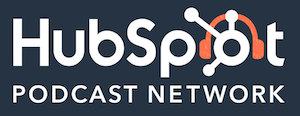
HubSpot Podcast Network is the audio destination for business professionals who seek the best education and inspiration on how to grow a business.

